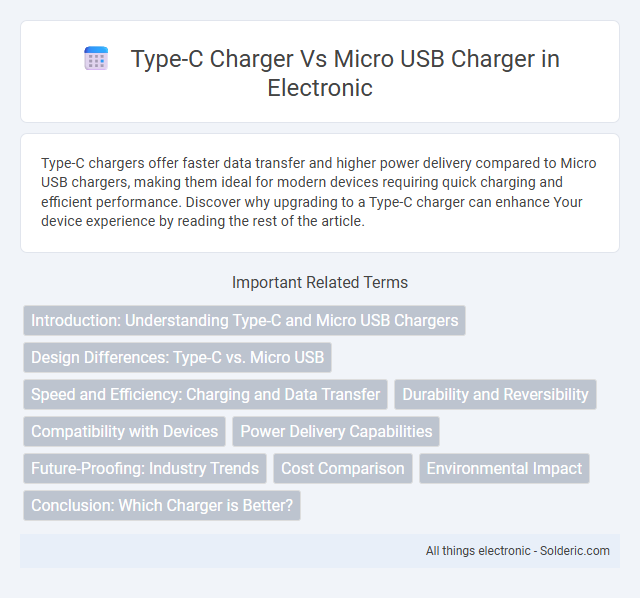Type-C chargers offer faster data transfer and higher power delivery compared to Micro USB chargers, making them ideal for modern devices requiring quick charging and efficient performance. Discover why upgrading to a Type-C charger can enhance Your device experience by reading the rest of the article.
Comparison Table
| Feature | Type-C Charger | Micro USB Charger |
|---|---|---|
| Connector Design | Reversible, oval-shaped | Non-reversible, trapezoid-shaped |
| Data Transfer Speed | Up to 10 Gbps (USB 3.1) | Up to 480 Mbps (USB 2.0) |
| Power Delivery | Supports up to 100W (PD 3.0) | Up to 15W |
| Compatibility | Widely used in modern smartphones, laptops, tablets | Older smartphones, small devices |
| Durability | More durable, supports more insertions | Less durable, prone to wear |
| Audio/Video Support | Supports alternate modes like DisplayPort | No support |
| Adoption Year | Introduced in 2014 | Introduced in 2007 |
Introduction: Understanding Type-C and Micro USB Chargers
Type-C chargers feature reversible connectors and faster data transfer rates compared to Micro USB chargers, which have a distinct top and bottom orientation and slower charging capabilities. The Type-C standard supports higher power delivery up to 100W, making it ideal for charging larger devices efficiently. Your choice between these chargers affects charging speed, device compatibility, and overall convenience.
Design Differences: Type-C vs. Micro USB
Type-C chargers feature a reversible and symmetrical design, enabling easy plug-in from either side, while Micro USB chargers have a distinct trapezoidal shape that fits only one way. The Type-C connector is more compact and robust, supporting higher power delivery and faster data transfer rates compared to the older Micro USB design. This improved form factor enhances user convenience and durability in charging and connectivity applications.
Speed and Efficiency: Charging and Data Transfer
Type-C chargers deliver faster charging speeds and more efficient power transfer compared to Micro USB chargers, supporting up to 100W of power through USB Power Delivery technology. Their symmetrical connector design ensures easier, reversible plugging and enables higher data transfer rates of up to 10 Gbps with USB 3.1, significantly outperforming Micro USB's maximum of 480 Mbps under USB 2.0. Choosing a Type-C charger enhances your device's charging efficiency and accelerates large file transfers seamlessly.
Durability and Reversibility
Type-C chargers offer superior durability compared to Micro USB chargers due to their robust design and reinforced connectors that withstand frequent plugging and unplugging. The reversible design of Type-C connectors eliminates the frustration of incorrect insertion, enhancing user convenience and reducing wear over time. Choosing a Type-C charger for your devices ensures longer lifespan and effortless connectivity, improving your overall charging experience.
Compatibility with Devices
Type-C chargers offer broader compatibility with newer smartphones, tablets, and laptops due to their reversible design and higher data transfer rates. Micro USB chargers remain compatible with many older devices but lack the versatility and power delivery capabilities of Type-C connectors. Ensuring your device supports Type-C can enhance charging speed and future-proof your accessories.
Power Delivery Capabilities
Type-C chargers support higher Power Delivery (PD) capabilities, enabling fast charging up to 100 watts, which is ideal for laptops, tablets, and smartphones. Micro USB chargers typically offer lower power outputs, limited to around 15 watts, restricting their ability to charge devices quickly or support power-hungry electronics. The advanced power negotiation standards in Type-C enable dynamic voltage and current adjustments, enhancing charging efficiency and device compatibility.
Future-Proofing: Industry Trends
Type-C chargers are rapidly becoming the global standard due to their reversible design, faster data transfer, and higher power delivery capabilities, making them a future-proof choice. Many leading electronics manufacturers are phasing out Micro USB in favor of USB Type-C to comply with new regulations and consumer demand for unified charging solutions. Your investment in a Type-C charger ensures compatibility with upcoming devices and industry trends emphasizing efficiency and convenience.
Cost Comparison
Type-C chargers typically cost more than Micro USB chargers due to their advanced technology and faster data transfer capabilities. However, the price gap has been narrowing as Type-C becomes more widespread and affordable production methods improve. Investing in a Type-C charger may offer better value over time because of its compatibility with newer devices and durability compared to Micro USB options.
Environmental Impact
Type-C chargers contribute to reducing electronic waste by providing a universal charging standard compatible with various devices, unlike Micro USB chargers that require multiple cable types for different devices. The durability and reversible design of Type-C cables result in fewer replacements, thus minimizing plastic waste and resource consumption. Transitioning from Micro USB to Type-C technology supports sustainable manufacturing processes and aligns with global efforts to decrease e-waste pollution.
Conclusion: Which Charger is Better?
Type-C chargers outperform Micro USB chargers by offering faster data transfer speeds, higher power delivery for rapid charging, and a reversible design that enhances user convenience. Micro USB remains compatible with older devices but lacks the advanced features and efficiency of Type-C technology. Your best choice for future-proof charging and optimal performance is a Type-C charger.
Type-C charger vs Micro USB charger Infographic

 solderic.com
solderic.com